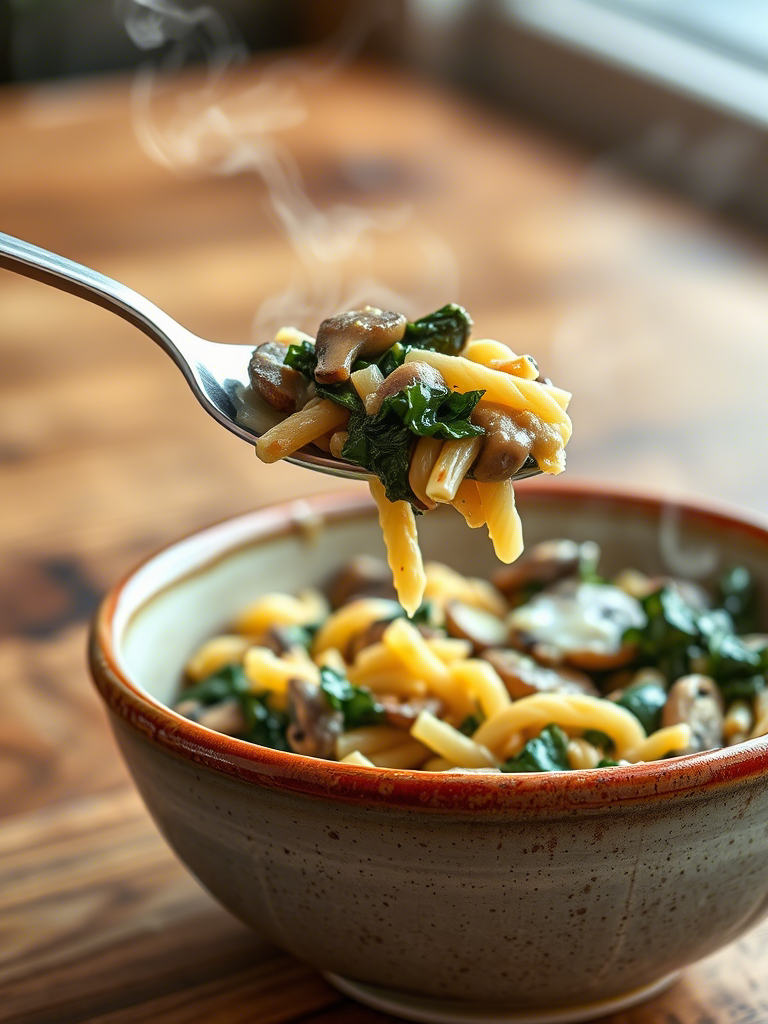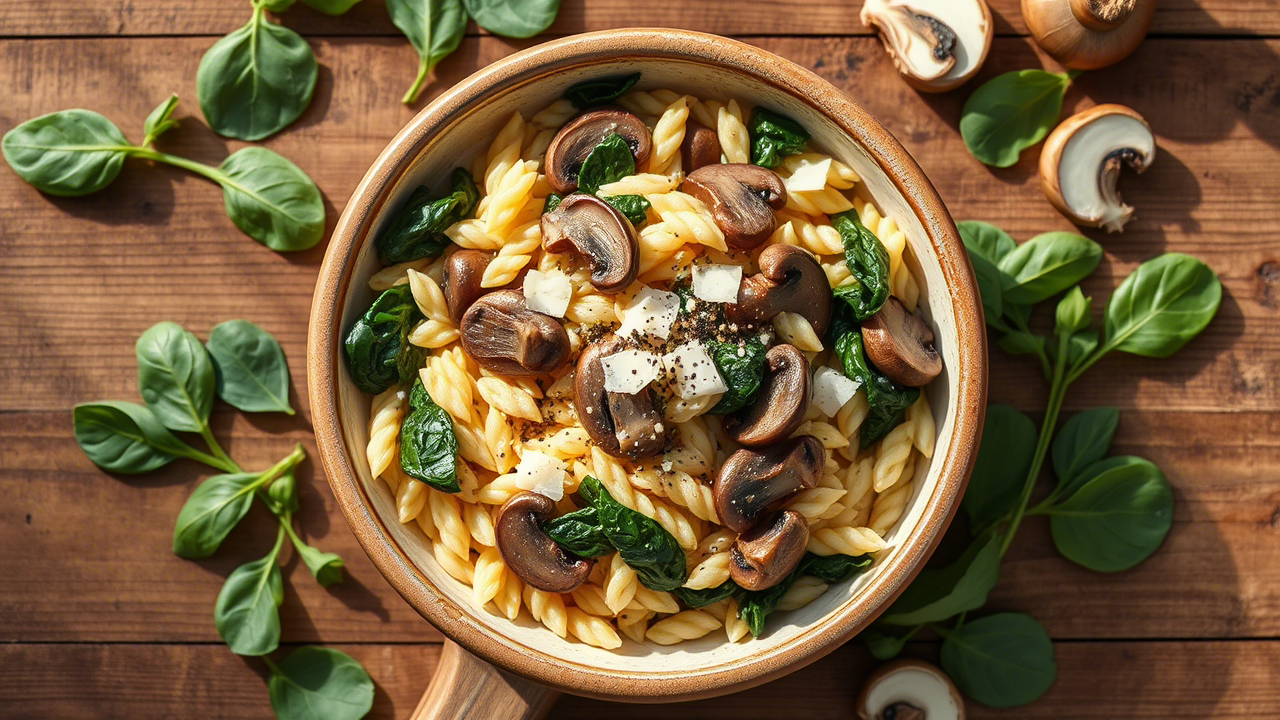You ever cook something, plate it, take a bite, and pause—like properly freeze—and wonder why in the world it tasted that right? That’s spinach mushroom orzo. Humble. Unassuming. Not the dish that screams fireworks, but one that whispers elegance and hits deep like a favorite worn-out hoodie.
Let’s be honest. Most folks sleep on orzo. They think it’s rice, or maybe pasta, or…some weird hybrid that belongs in a forgotten pantry. But chefs—real ones, not TikTok pretenders—we know better. Orzo is the secret scaffolding of a dish that hugs the veg, soaks up stock like a sponge, and carries umami like a stagehand with a spotlight. And when you pair it with spinach and mushrooms? It becomes something else entirely.
This isn’t just about a cozy one-pan meal. This is about texture, structure, aroma, and balance. Let’s unpack what makes spinach mushroom orzo a dish worth knowing by heart.
The Culinary Science Behind Orzo
Technically, orzo is a short-cut pasta made from durum wheat semolina. It holds its shape better than most short pastas, which is why it behaves like a grain in dishes that don’t want the chew of barley or the fluff of rice. It’s the introvert at the party—quiet, dependable, and weirdly magnetic once you get to know it.
Durum wheat’s high protein content gives orzo a firm bite, crucial in professional kitchens where consistency is everything. Overcooked orzo turns into mush in minutes, so precision in timing is essential—al dente or nothing. Treat it with the respect you’d give risotto rice, and it’ll reward you tenfold.
If you’re finishing the orzo in a broth-based reduction, remember it absorbs about 1.5x its weight in liquid. Use this to your advantage. Don’t drown it. Let it sip.
Mushrooms: Umami Kings With Earth Under Their Fingernails
Mushrooms are the reason this dish works. Spinach is delicate and slightly metallic on the tongue. Orzo is all starch and body. You need something earthy—fleshy even—to ground it all. That’s mushrooms.
Use cremini if you’re playing it safe, shiitake if you’re bold, and mix in a few dried porcini if you want to flex. The key here isn’t just the type, it’s the method.
Don’t crowd the pan. Ever. Mushrooms need space, like moody artists in a shared loft. Too many in the pan and they steam. What you want is caramelization. High heat, oil that’s shimmering but not smoking, and patience. Let them sit before stirring. Let the browning happen. The Maillard reaction is your co-chef in this dish.

Spinach: The Gentle Touch With a Bitter Backbone
Spinach is easy to overthink. But here’s a truth bomb: you don’t need to baby it. Add it raw at the end and just let the residual heat wilt it down. If you sauté it earlier, you lose volume and flavor. A pound of fresh spinach turns into something that fits in a coffee cup—and it tastes like nothing if overdone.
Also, use fresh. Always fresh. Frozen spinach brings water and bitterness, and you can’t wring that out without breaking the rest of the dish. Buy the big leaves, not baby spinach. They hold structure better and add a faint grassy bitterness that balances the umami from the mushrooms.
The Stock Matters More Than You Think
Listen. If you’re cooking your orzo in water, you’re wasting your time. This dish lives and dies by its stock. Homemade veggie stock, mushroom broth, even a rich poultry stock—each brings a different personality.
A 2021 culinary analysis by the ICCA (International Culinary Center Archives) noted that flavor absorption in small pastas like orzo is 27% higher when simmered in fat-rich broths compared to water. That’s not small potatoes. That’s science saying: your base flavors are literally soaking into the starch.
Add aromatics to your broth: garlic skins, thyme stems, even a dash of miso paste. It doesn’t take much to upgrade a base, and the return is exponential.
One Pan, Zero Fuss, Maximum Impact
Professional kitchens thrive on efficiency. Spinach mushroom orzo is a one-pan wonder. Less cleanup, more concentration of flavor. Here’s how the build goes down:
- Sauté shallots in olive oil till translucent. Add garlic, give it 30 seconds.
- Toss in mushrooms, cook hard and fast. Season early to draw out moisture.
- Stir in orzo dry—toast it a bit. This gives depth and nuttiness.
- Deglaze with a splash of dry white wine (or vermouth if you’re cheeky).
- Add stock gradually. Not all at once—like risotto. Stir occasionally.
- When orzo is almost done, fold in spinach. Lid on. Let the heat work.
- Finish with a knob of butter and a dusting of Parmigiano if dairy’s on the table.
That’s your blueprint. From here, you can riff endlessly.
Variations That Actually Work (And Some That Don’t)
Don’t throw in everything but the kitchen sink. Respect the dish. But that said, there’s room for interpretation:
- Add roasted garlic purée for a richer undertone.
- Swap spinach for chard or kale (but blanch tougher greens first).
- Stir in crème fraîche for silkiness without heaviness.
- Try wild mushrooms and finish with truffle oil if you want a luxury lift.
Now—what doesn’t work?
- Overcomplicating it with protein. Chicken or shrimp? Fine. But don’t go grilling a ribeye and expecting harmony.
- Heavy tomato sauces. The acidity competes instead of complements.
- Frozen veg. They water down your work. If you have to use frozen, reduce your broth volume by 20%.

Let’s Talk Texture—It’s Everything
In fine dining, mouthfeel is a silent critic. Orzo, when done right, gives a creamy bite without cream. That’s key. You want that loose, barely-holding shape consistency—like a risotto that’s taken a deep breath.
The mushrooms should offer a chew—think seared scallops, not boiled fungus. And the spinach? It’s your silk. A contrast to the starch and the flesh. This balance is deliberate, and when one part’s off, the whole dish slides.
Nutrition with No Apologies
Here’s a dish that’s naturally balanced. You’ve got fiber, iron, vitamin K, plant-based protein, and complex carbs. According to a 2023 study by the European Journal of Nutrition, a serving of spinach-mushroom orzo (roughly 1.5 cups) offers 18-22g of protein and nearly 70% of the RDA for folate and iron—especially when using fresh spinach and a mushroom-rich base.
This isn’t just comfort food. It’s fuel. Especially for those leaning into plant-forward diets.
Common Misconceptions
“Orzo is just filler.”
False. It’s a carrier. Like a background actor that ends up stealing the scene. Orzo wants to soak up flavor, not just sit there looking pretty.
“You need cream or cheese to make it rich.”
Nope. Try reducing your broth a bit more and adding a swirl of good olive oil at the end. You’ll get a mouthfeel that rivals béchamel.
“It won’t impress on a menu.”
That’s where plating comes in. Serve it in a wide, shallow bowl, top with shaved mushroom slices and a slick of infused oil, and it screams “elevated bistro.” Simplicity is the new sophistication—don’t forget that.
Trends: Orzo Is Having a Moment (Finally)
In 2025, chefs are waking up to orzo. Plant-forward menus, Mediterranean-style diet trends, and the rise of ancient grain alternatives have pushed pasta’s weirder cousins into the spotlight.
Data from the NRA (National Restaurant Association, not that NRA) 2024 trend report showed a 19% year-over-year increase in orzo usage on upscale menus. And that’s not counting what’s happening on the personal chef scene.
Spinach mushroom orzo hits the holy trifecta: sustainable, scalable, and Instagrammable.
Final Notes and Pro Tips
Wanna elevate it? Hit it with a lemon zest grating just before serving. Or toast some pine nuts and sprinkle on top. Textural contrast + fat + acid = layered flavor.
Batch prep it, but reheat with extra broth. Orzo gets clingy in the fridge, and a splash of hot stock wakes it back up.
And for service? Pair with a Grüner Veltliner or an unoaked Chardonnay. The minerality cuts through the starch and highlights the earthy mushrooms. Trust me—it sings.
The Takeaway
Spinach mushroom orzo isn’t just a midweek meal or a vegetarian fallback. It’s a case study in restraint, in balance, in the quiet brilliance of ingredients doing exactly what they were meant to do. It plays like jazz—simple structure, endless improvisation.
Every chef should have this in their back pocket. Because at some point, someone will ask for something comforting but clean, elevated but not fussy. And you’ll smile, walk to the kitchen, and start with orzo.
And that’s when they’ll know—they’re in good hands.
FAQs
What is spinach mushroom orzo?
It’s a savory one-pan dish made with orzo pasta, sautéed mushrooms, and wilted spinach, often finished in a flavorful broth.
Is orzo a type of rice?
Nope—it’s actually a small, rice-shaped pasta made from semolina wheat.
Can I use frozen spinach in this dish?
Technically yes, but fresh spinach gives way better texture and flavor—frozen tends to water it down.
What mushrooms work best for this recipe?
Cremini, shiitake, and porcini all work great—use a mix for more depth and earthiness.
Can this be made vegan?
Absolutely—just skip the butter and cheese, and use veggie or mushroom stock.
How do I prevent overcooking the orzo?
Cook it like risotto, adding broth gradually and tasting for doneness; al dente is your finish line.
What kind of broth is best?
A rich mushroom or homemade veggie broth adds the most depth—store-bought works in a pinch if well seasoned.
Can I add protein to this dish?
Sure, grilled chicken or shrimp can work, but keep it subtle—this dish isn’t meant to carry a steak.
How should I store leftovers?
Refrigerate in an airtight container and reheat with a splash of broth to loosen it up.
Does this dish work for meal prep?
Yes—just undercook the orzo slightly so it doesn’t go mushy when reheated.
What wine pairs well with spinach mushroom orzo?
A crisp Grüner Veltliner or unoaked Chardonnay balances the earthiness and starch perfectly.
Can I substitute orzo with another grain or pasta?
Farro or small pasta shapes can work, but the texture and cooking time will change a bit.
Is this dish gluten-free?
Not as written, but you can swap in gluten-free orzo or a rice alternative to make it celiac-friendly.

Mariana is a passionate home cook who creates delicious, easy-to-follow recipes for busy people. From energizing breakfasts to satisfying dinners and indulgent desserts, her dishes are designed to fuel both your body and hustle.
When she’s not in the kitchen, she’s exploring new flavors and dreaming up her next recipe to share with the Foodie Hustle community.

